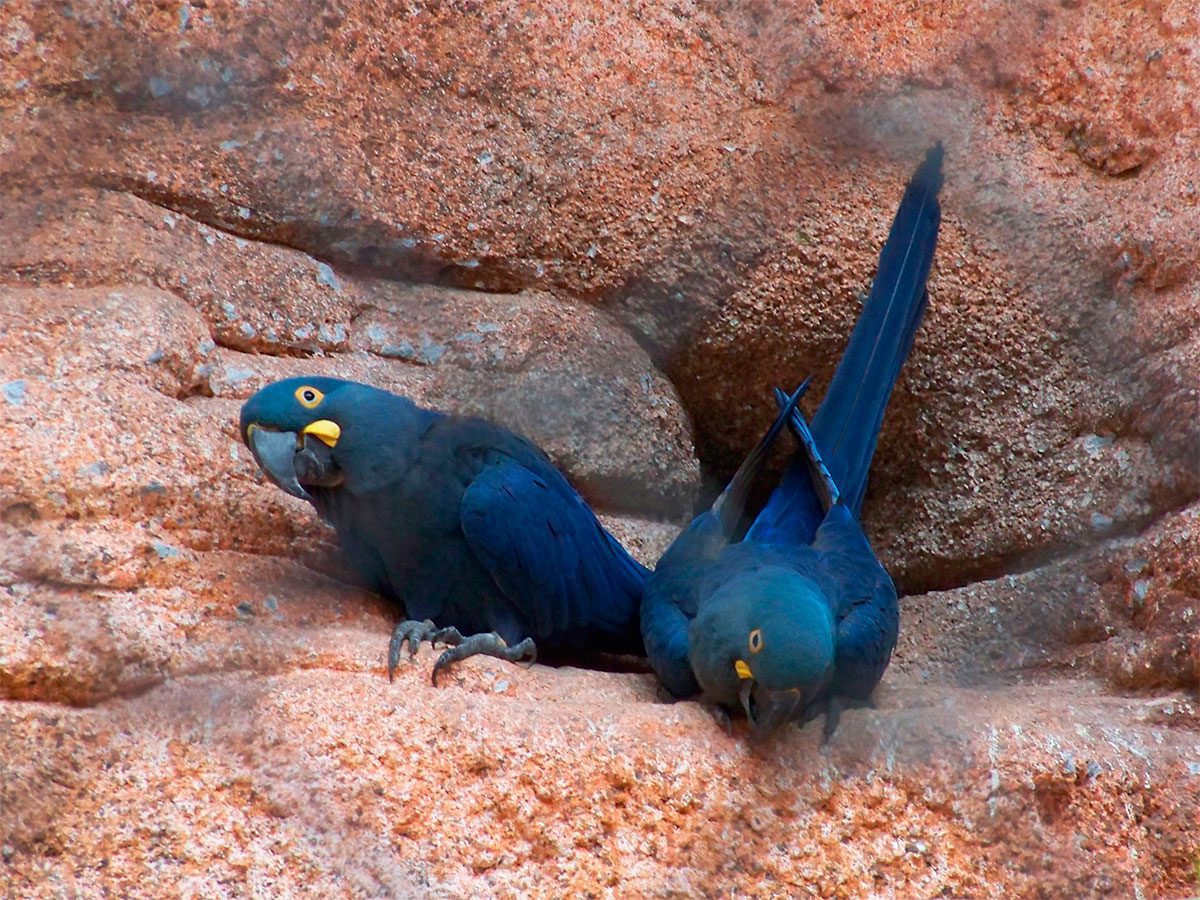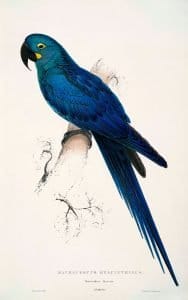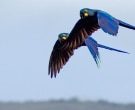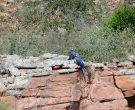Content |
|---|
Description:
75 cm.. length and 940 g. of weight.
The Indigo Macaw (Anodorhynchus leari) It is a beautiful Blue Parrot with a long tail. Similar to the Hyacinth Macaw, but much smaller and chunky, with a large yellow spot in the cheeks. It was described for the first time in 1858 by the nephew of Napoleon, Lucien Bonaparte, from an illustration by the famous English illustrator and artist known for his absurd poetry, Edward Lear.
This Parrot, However, remained elusive in nature, and it was only accepted as a distinct species in 1978, When the naturalist Helmut Sick finally found a wild population.
The head, the neck and underparts This Parrot are greenish-blue, While the rest of the body looks like a purple / indigo. The bare skin around the eyes and at the base of the bill It is pale yellow.
The irises are dark brown and the bill, Although predominantly black, You may have a grey stains clear.
Males and females They seem to. The male can have a larger beak and can usually be larger in size, but those differences vary or may be only slight and are not considered reliable for gender identification.
The youth they can be identified by its shorter tail; the upper beak is pale.
- Sound of the Indigo Macaw.
Habitat:
They live in drylands, with resistant vegetation of caatinga (thorny scrub), especially in areas with Palm trees Syagrus coronata.
They require sandstone cliffs to perch and nest.
gregarious and in general in flocks, although usually in very small numbers. Shapes communal roosts in cracks eroded near the top of the walls of canyons of sandstone at altitudes between 30 and 50 m. Many birds perch on the largest holes, while others cling to rocks or rest on the cornices.
The Indigo Macaw leave the roosts in family groups to go to the feeding areas before dawn to return at dusk.
Reproduction:
The nests of the Indigo Macaw they are located in crevices in cliffs, Although sometimes they also nest in shallow tree cavities.
The breeding season It is located in the months February-April, coinciding with the rainy season and possibly coinciding with the maximum availability of palm nuts.
The average clutch size is two to three eggs. The average period of incubation is of 28 days and the average age of feathered is of 16 to 20 weeks.
Food:
The staple food of the Indigo Macaw they are palm nuts Syagrus (a bird can take 350 nuts in a day). Also take seeds from Melanoxylon, above all when the walnuts Syagrus they are scarce (July-September). Other reported foods include fruits of Jatropha pohliana, Dioclea and Spondias tuberosa, flowers Agave and corn.
Fluid from the unripe fruit of Palms is perhaps the main source of moisture.
The Indigo Macaw they feed in the trees and on the ground.
Distribution:
Confined to the plateau Raso da Catarina, to the northeast of Bay in Brazil; mainly occupy an area close to 8,000 km 2 in the center of Río Vasa Neighborhoods, in the South of the plateau. Two main colonies are known, one on each side of the Vasa Barris.
These birds make daytime movements South of Holy and Euclides da Cunha and possibly from the North to the north-western edge of the plateau to feed.
There is a peripheral population smaller at several hundred kilometers of Vasa Barris and there are unconfirmed reports of other small groups in remote northern dry inside of Bay.
Resident, remaining close to the cliffs where nest and their favorite roosting birds.
The population of Indigo Macaw is estimated at 139 birds (117 more 22) with an evident decline during the last 100 years. The pressures arising from the trade in birds, hunting, the loss of plants used as food for livestock, the disturbance and, possibly, inbreeding depression, could quickly lead to extinction in freedom of this beautiful species.
Conservation:
• Current Red List of UICN: Danger
• Population trend: Unknown
The Indigo Macaw suffered a historic long-term drop due to the capture, but estimates of population remained fairly stable after its rediscovery in the wild in 1978 until the mid of 1990 when the numbers began to rise rapidly; While this may reflect in part, improvements in the survey methodology, also there has been a real increase due to intense conservation efforts.
According to specialists, they only survive in the world, mainly in zoos, a few 1.300 specimens This species whose natural habitat are the rock walls in the arid interior of the state of bahia (Northeast of Brazil).
For its part, the Spix's Macaw It is considered extinct in the wild since 2000, Although currently survive in captivity a few 90 specimens, that are maintained by institutions from different countries, mostly out of Brazil.
"Indigo Macaw" in captivity:
The Indigo Macaw It is the most uncommon of all the macaws in captivity. There are three known copies in United States and a similar amount in Europe. The Government of Brazil does not recognize any other legal specimen of this species outside its borders. On the other hand, in the zoos of Rio de Janeiro and São Paulo in Brazil, they have several copies. Twelve copies of Indigo Macaw with that features the Zoo's São Paulo they are isolated and in cages that cannot be visited by the public due to the risk of extinction of the species.
With regard to its longevity, They have News of a captive bird that lived 38,3 years.
During the last ten years, attempts to smuggle this species have been discovered from Brazil and some birds have confiscated, who have been returned to the country.
A Special Committee has been formed by the part of the IBAMA of the Government of Brazil to initiate actions for the conservation of this species. Likewise, other countries that have also signed the treaty CITES they should support Brazil in their attempts to establish pairs of players in captivity and to conserve the habitat of the Indigo Macaw.
If anyone knows the whereabouts of illegal copies of this species must notify the authorities for his immediate intervention. This species is on the verge of extinction and all possible actions to save her must be coordinated through a working group for the conservation.
Notes:
They are accomplished in Brazil the first reproduction in captivity of a Lear's macaw
Alternative names:
– Indigo Macaw, Lear’s Macaw (English).
– Ara de Lear (French).
– Learara, Lear-Ara (German).
– Arara-azul-pequeña, arara-azul-de-Lear, arara-azul-pequena (Portuguese).
– Arara-azul-de-lear, arara-azul-pequena (Portuguese (Brazil)).
– Guacamayo de Lear, Guacamayo Indio (español).
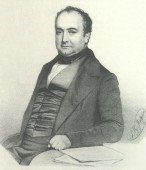
scientific classification:
– Order: Psittaciformes
– Family: Psittacidae
– Genus: Anodorhynchus
– Scientific name: Anodorhynchus leari
– Citation: Bonaparte, 1856
– Protonimo: Anodorhynchus leari
Images Indigo Macaw:
Videos "Indigo Macaw"
“Indigo Macaw” (Anodorhynchus leari)
Sources:
– Avibase
– Parrots of the World – Forshaw Joseph M
– Parrots A Guide to the Parrots of the World – Tony Juniper & Mike Parr
– Birdlife
– Wildscreen Arkive
– Macaws. A Complete Guide by Rick Jordan.
– Photos:
(1) – Two Lear’s Macaws at Rio de Janeiro Zoo, Brazil By Marcos Pereira (originally posted to Flickr as blue macaw couple) [CC BY 2.0], via Wikimedia Commons
(2) – Lear’s Macaw Anodorhynchus leari By https://www.flickr.com/photos/jquental [CC BY 2.0], via Wikimedia Commons
(3) – Two Lear’s Macaws at Canudos Biological Station, Bahia, Brazil By Miguelrangeljr (Own work) [Public domain], via Wikimedia Commons
(4) – Anodorhynchus lear By Rick elis.simpson (Own work) [CC BY-SA 3.0], via Wikimedia Commons
(5) – PROGRAMA DE CATIVEIRO DA ARARA-AZUL-DE-LEAR by Fabio Nunes – icmbio.gov.br
(6) – Illustration by Edward Lear (1812–88) first published in his book Illustrations of the Family of the Psittacidae, or Parrots in 1832
– Sounds: Hans Matheve (Xeno-canto)
